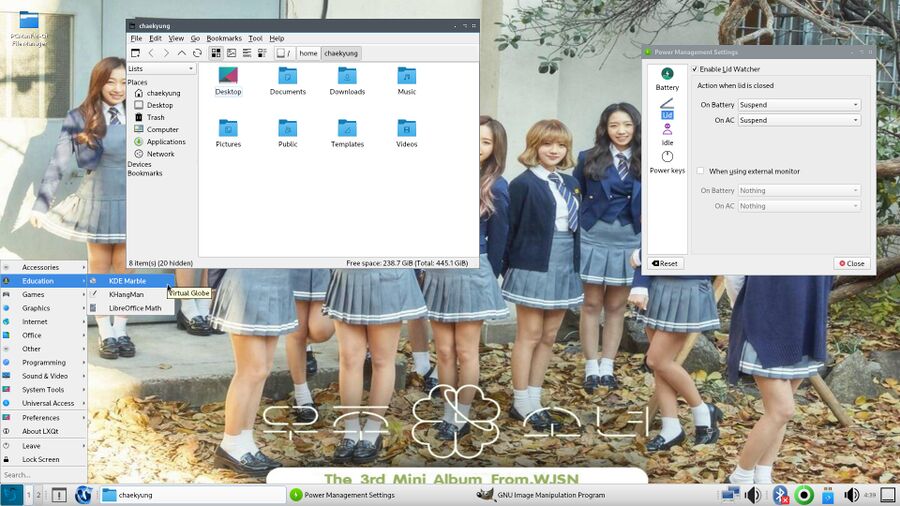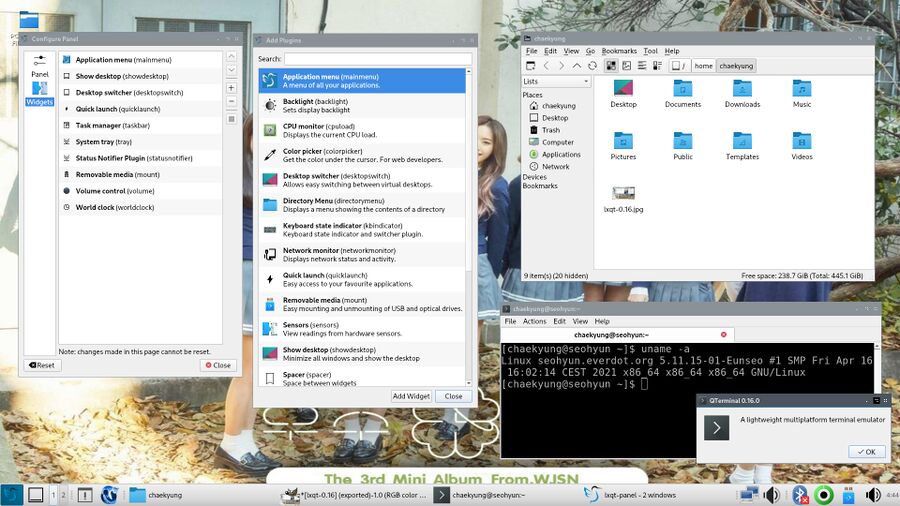LXQt Desktop 0.17 Is Released
Better power management options, the ability to only auto-hide the panel when it is covered by a window and better session management are the highlights in the latest version of the very light-weight LXQt desktop environment.
written by 윤채경 (Yoon Chae-kyung) 2021-04-17 - last edited 2021-04-17. © CC BY

The LXQt desktop environment, version 0.16.
LXQt is a pretty bare-bones and light-weight desktop environment with a traditional desktop with icons on it, a simple panel, or panels, a power manager, a file manager, (pcmanfm-qt) and a terminal qterminal. The window manager it uses is openbox, a window manager developed completely independent on the LXQt project. The openbox settings manager has been removed from the LXQt session in this release to make it easier to use LXQt with other window managers.
The latest LXQt 0.17 release has several mostly tiny improvements. Session management has been improved to include the most basic feature session management should have: Desktop applications are now notified when LXQt quits. This gives them a chance to exit cleanly instead of being abruptly terminated when the X server terminates.
The PCManFM-Qt file manager that comes with LXQt has gained support for file creation times and a "Admin mode" in the tools menu that lets you transfer files between root and your regular user without the need to actually be root. This feature is, sadly, currently broken due to a problem in the underlying GNOME Virtual file system (GVFS) framework it depends on. It will work if that bug gets fixed.
PCManFM-Qt is in no way tied to the LXQt desktop environment, it is a perfectly decent very light-weight file manager that works fine in fluxbox, IceWM and other window managers. The LXQt desktop environment doesn't have it's own window manager, it will simply loads and uses the openbox window manager.
The QTerminal terminal has gained support for 5 different background image modes and an option to disable bracketed paste mode. It is overall a perfectly fine light-weight terminal and it is, like PCManFM-Qt, something that works fine in any window manger or desktop environment.

The LXQt desktop environment, version 0.16, with panel settings open.
The LXQt panel is now capable of "smart" auto-hiding, or "Intelligent" hiding as Xfce calls it. This is a auto-hide setting where the panel is visible unless some application covers it by being maximized or moved to an area of the screen where a panel lives.
The LXQt Power Manager has gotten separate idle watchers for AC and battery power. It still lacks support for basic things like hybrid (ram+disk) suspend, but it does have the basics in place such as suspend or other action when a laptops lid is closed.
Wayland support for LXQt, something that has been discussed since 2014, is still off the table. One option being discussed would be to replace the openbox window manager LXQt uses with KWin from KDE Plasma. The Deepin desktop environment the Deepin Linux distribution offers has a window manager based on KWin. LXQt could go that route, but it seems unlikely. It is more likely that it will remain a X-only desktop environment for the foreseeable future.
The LXQt website is at lxqt-project.org. Downloading it is a lot of work, you will have to go to the LXQt GitHub page at github.com/lxqt and download each individual component. The tarball available at github.com/lxqt/lxqt/releases/tag/0.17.0 does not contain LXQt or any of the components, it contains a few build scripts and cmake files and that's it. There is not a single C source file, or anything else beyond build scripts, in that file. Getting it from one of the many distributions with LXQt packages in their repositories is a far, far easier route.


Enable comment auto-refresher